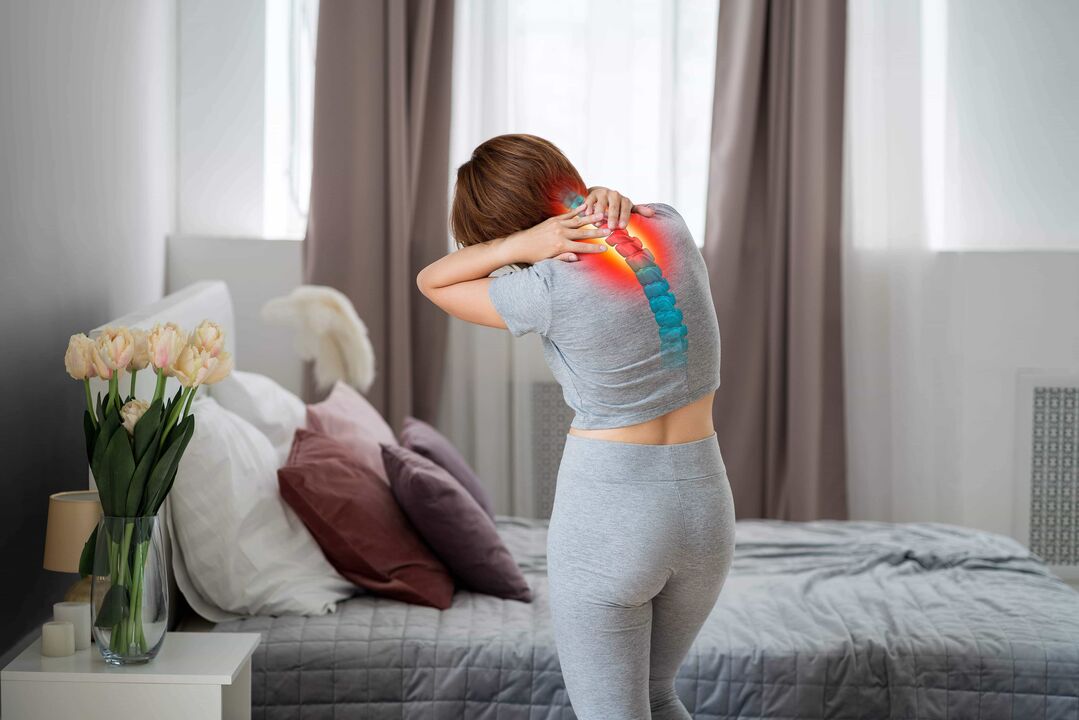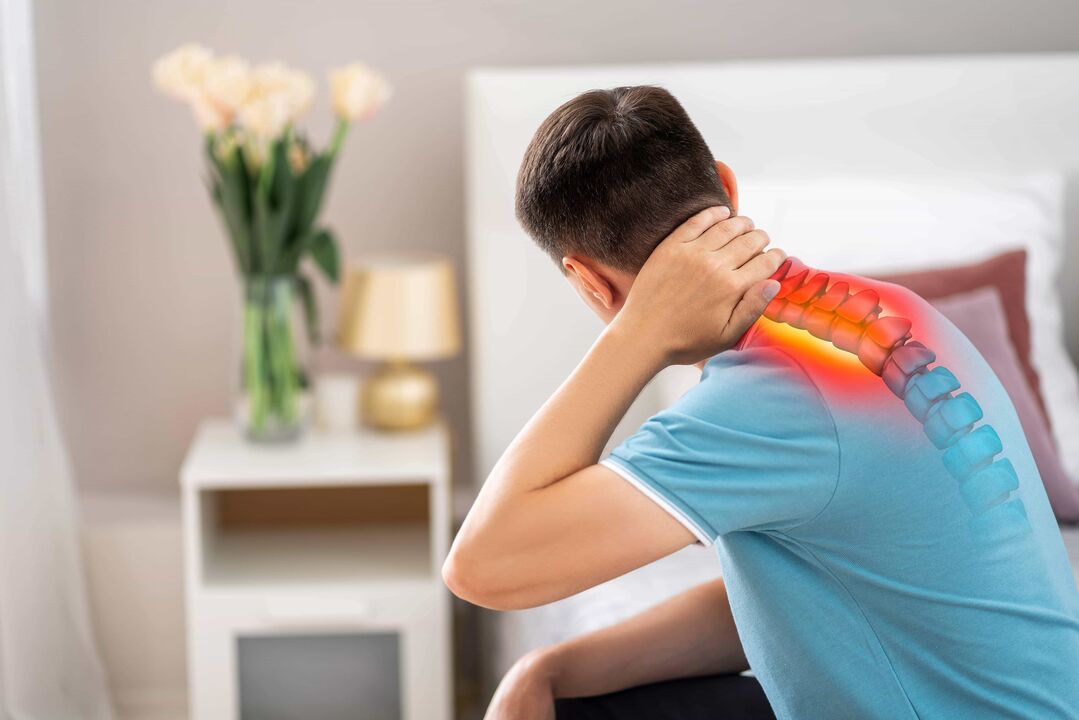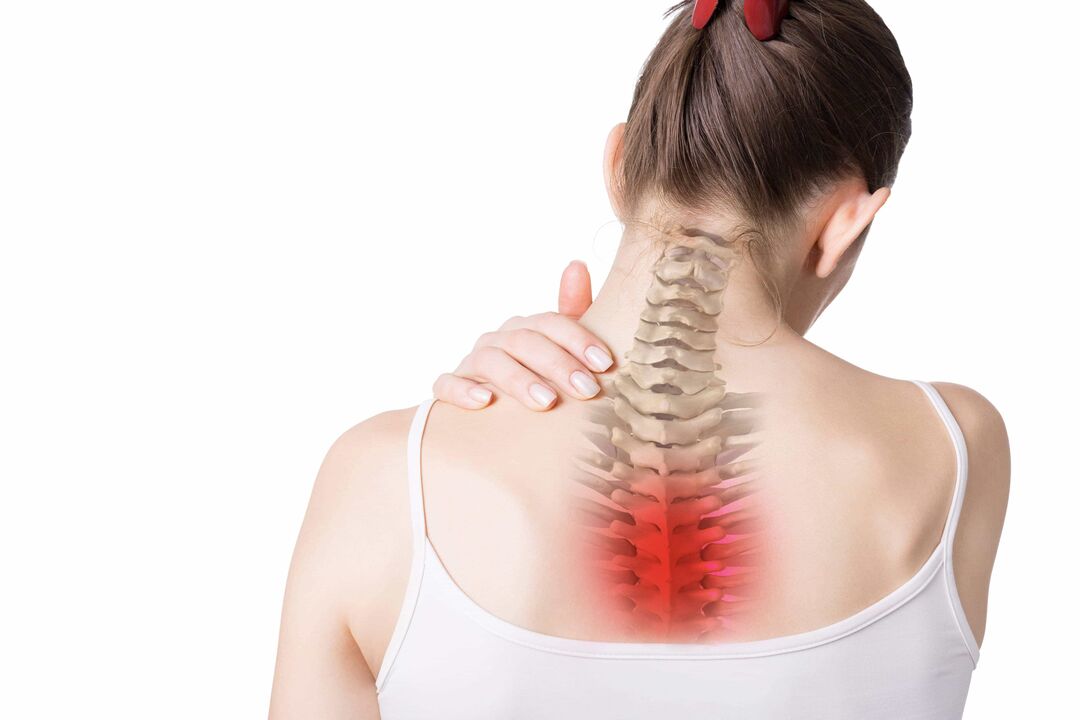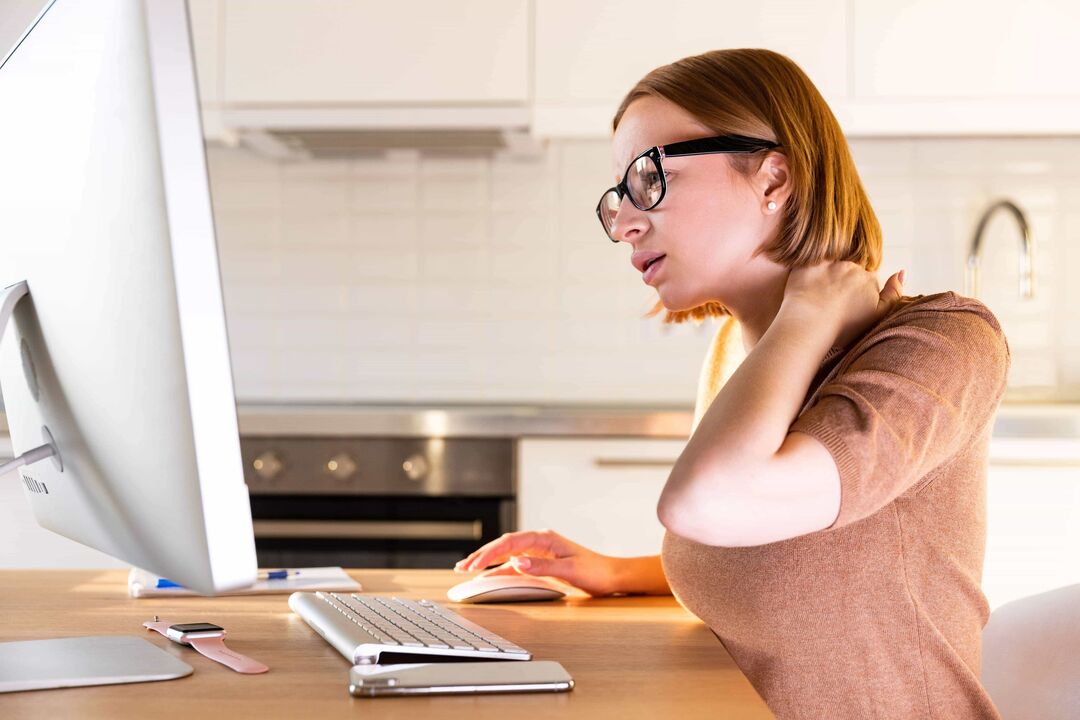Osteochondrosis is a common disease in which a person feels pain and limited movement in different parts of the back. In the past, it was thought that the disease was only specific to the elderly, but in recent years, younger patients have increasingly suffered from osteonecrosis. According to statistics, every second the inhabitants of the planet are prone to back pain.

Osteochondrosis in women
The human spine consists of 32-34 vertebrae, linked together in a vertical position. Between the vertebrae are layers of cartilage - the so-called cartilaginous discs. They bring flexibility and mobility of the spine during movement.
What is osteonecrosis? This is a pathology of the spine, the basis of which is the destruction of the discs, then the vertebrae themselves. These discs are destroyed over time leading to complications such as protrusion (partial bulging of the disc) and vertebral herniation.
Most often, osteonecrosis affects residents of large cities. Therefore, sedentary work, lack of movement leads to static overload of the spine.
The reasons
When a person walks, the load on the spine is unevenly distributed. The discs are compressed, the distance between the vertebrae is reduced, so the disc cartilage tissue is destroyed. If the disease does start, the nerve roots are also damaged. In this case, the patient may have pain in the nerve root area, and at the same time have a tingling, burning sensation, feeling like "ants crawling". The pain may occur with prolonged sitting in an uncomfortable position, squeezing the arm or leg. In addition, there are risk factors.
Bone tumors can cause a number of diseases of the musculoskeletal system, such as: flat feet, scoliosis, diseases of the musculoskeletal system. In addition, osteonecrosis is also found in endocrine diseases, for example, metabolic disorders, diabetes mellitus and thyroid diseases. Lifestyle also affects the course of the disease. If a person is constantly in an uncomfortable position, standing or sitting for a long time, a sedentary lifestyle, then all these lead to the destruction of the discs. Malnutrition with mostly fat and vitamin and mineral deficiencies can also cause spine problems. If a person has had trauma, bruises, and spinal surgery, this can cause an exacerbation of osteonecrosis.
Heredity negatively affects the course of the disease.

Bone tumors in men
Bad habits (smoking, drinking a lot of alcohol) also have a bad effect on the spine. Nicotine adversely affects metabolism, causing the discs to weaken. Excess weight puts extra stress on all parts of the spine, eventually damaging the discs. A sedentary lifestyle is also not beneficial for the spine. When inactive, the load on the back increases, the discs are "wiped out" and the cartilage is damaged. With excessive physical exertion and playing professional sports, minor injuries of the spine also occur. The first symptoms of osteonecrosis may not appear immediately.
Types of osteonecrosis
Cervical
The neck is a very mobile part of the body, it undergoes many side rotations every day. There are seven small vertebrae in the neck, which are connected to each other by special discs. The disease of this part is considered quite serious, since in the cervical region there are many vessels (arteries and veins), as well as nerve roots responsible for the vital systems of the body. Cervical fibroids often complicate blood saturation of the head, so the brain is also affected by it. It is believed that activities in this part of the spine can cause immobility, that is, a violation of movement throughout the body.
chest
The vertebrae of the thoracic region are not as mobile as the lower back and neck. Thoracic fibroids are for this reason less common than other types. Weightlifters, as well as athletes, are more likely to develop this back problem than other people. There are cases when thoracic bone tumors are confused with myocardial infarction, lung diseases. For an accurate diagnosis, it is necessary to examine and consult with a doctor.
Belt (or lumbosacral)
The lumbar spine consists of five vertebrae connected by intervertebral discs. These vertebrae are large and strong, able to bear the weight of the human body. However, if the metabolism is disturbed, the vertebrae will quickly become less elastic and less elastic, and the nerve roots of the lower back will also be damaged. The result is a person with severe lower back pain that radiates down the leg or groin.
If the sacral spine is also affected, such a process of bone necrosis is called lipoma. In this form, the failure is stronger and more serious. The patient has difficulty walking, sometimes with paralysis of the legs due to damage to the spinal cord and nerve roots going to the lower extremities. Possible urinary incontinence.
Main symptoms
There is cervical, thoracic and lumbar osteonecrosis. The disease has many symptoms, manifestations depend on the extent of damage.
Symptoms of cervical osteonecrosis
The main symptom is pain in the neck, which is aggravated by turning and tilting the head. Painkillers work but don't last long. Dizziness and tinnitus are common. Some patients reported face and neck numbness and arm weakness.
Symptoms of thoracic osteonecrosis
Happens less often. With this type of osteonecrosis, the patient has pain in the chest area, between the shoulder blades. Pain is worse when bending over and moving. There is a feeling of tightness in the throat, difficulty breathing. There may be numbness in the chest, pain in the heart, in the stomach.
Symptoms of lumbar osteonecrosis
The most common type of this disease. The main symptom is pain in the lower back, spreading to one or both legs, down to the groin, abdomen. Special sensations often arise when turning to the side, leaning.

Symptoms of osteonecrosis
Diagnose
The treatment of osteonecrosis is performed by a neurologist. To make a diagnosis, the doctor will order an examination. This is basically an X-ray image of the affected back, if a complication is suspected - protrusion and herniation of the spine, an MRI (magnetic resonance imaging) will be ordered. In some cases, ultrasound of the vessels of the vertebral arteries is performed.
The treatment
Treatment of osteonecrosis depends on the stage of the disease, on the age and individual characteristics of the person.
Therapy aims to relieve pain, relax muscles, and prevent complications. The main group in the treatment of the disease are non-steroidal anti-inflammatory drugs. These are drugs that reduce pain and inflammation. Anti-inflammatory drugs are available in the form of injections, as well as tablets. Release by prescription.
In addition, muscle relaxants are used - drugs that relax the spasmodic muscle, as a result, muscle pain is reduced. Usually used for external use. Such drugs relieve pain, creating a "distracting" effect, i. e. warm or cool.
For pain relief, topical agents are excellent. Such ointments and creams help to reduce swelling, reduce inflammation and relieve pain at the site of injury.
Medicines do not have a cumulative effect and, importantly, they are dispensed without a prescription. These funds reliably relieve pain in any part of the spine.
Among them, warming ointments can be distinguished - their effect occurs in about half an hour. Their action is to dilate blood vessels in the skin, inhibiting the transmission of nerve impulses to the brain.
However, it should be remembered that ointments with analgesic effect can adversely affect people with exacerbations of diseases of the gastrointestinal tract.
In addition, there are other external agents - patches, which also help reduce pain and swelling. These patches are available without a prescription.
Along with pain relief, prescribe medications that restore nerve roots. These are the B vitamins. They are prescribed as injections or as oral tablets.
In addition to drug treatment, the patient is prescribed a special bandage and bra. Such products unload the spine, improve metabolism and strengthen the structure of the intervertebral discs. Indicated after eliminating pain in the spine.
As written above, with osteonecrosis, the elasticity and mobility of the discs are impaired. To restore this important structure, therapeutically used chondroprotectors drugs, these drugs restore cartilage and prevent their destruction. They are used only as directed by a doctor, courses.
After eliminating the pain and inflammation, it is necessary to recover. For this, physiotherapy is used: massage, acupuncture, electrical stimulation. Massage is prescribed no earlier than 3-6 months after treatment. If a person has protrusion and hernia, spinal traction should be used.
Exercise therapy for osteonecrosis
Exercise therapy and gymnastics are an important adjunct to the treatment of osteonecrosis. The prerequisite is that the exercises are performed only after the back pain subsides. For each patient, exercises are selected individually, depending on the age and characteristics of the body.
Exercise with the method of bone destruction improves blood circulation and metabolism, strengthens the back muscles. Thanks to this strengthening, the spasms and excessive tension in the spine will pass, the back becomes more elastic. Regularity of performance and individual choice of exercises are important. In addition, exercise is a proven and effective way to prevent the development of the disease itself. Therefore, a little exercise in the morning as well as five minutes at work will benefit your back.
How to sleep properly?
It is believed that sleeping on your back is most helpful. This is the most comfortable position for the spine, because in this position all the muscles are completely relaxed. In addition, with lumbar degenerative disease, a small roller or pillow should be placed under the knee. Do not sleep on your stomach - it is bad for the cervical spine.
In this position, a person turns his or her head, and as a result, important vessels and nerve roots in the neck are compressed, blood circulation is disturbed. As a result, the blood is not enough to the head, dizziness, headache, and numbness may appear. The body position on the side is also considered acceptable.

Bone tumors can occur due to long time working with the computer
Pillows and mattresses
Mattress
For proper and healthy sleep, it is better to choose orthopedic products. An orthopedic mattress is useful for all parts of the spine, it allows you to maintain a natural anatomical curve - this improves blood circulation in the back. Back muscles when lying on such a mattress are in the most comfortable and relaxed state, the patient will get enough sleep.
Mattresses come in different types: hard, soft, medium hard. It is worth choosing individually.
- For children and teenagers, a medium to high firmness mattress will be very helpful.
- For people over 25 with a healthy back, a mattress with moderate firmness is recommended.
- In the case of scoliosis and other back problems, buying a firm mattress is worth it.
Pillow
An important factor for healthy sleep is the choice of pillow. It should be soft and comfortable enough to support the curves of the spine and relieve tension from the muscles in the neck. Pillows have the effect of enhancing sleep, helping to relax the neck and head, improving blood circulation. These pillows help maintain posture, as well as eliminate snoring.
I would like to add that comfort and a conducive environment are necessary for a healthy sleep. Do not stress before going to bed, avoid physical activity. You can take a relaxing bath with salt or herbs (lavender, chamomile). You need to sleep in a well-ventilated room with humidity (40-60%).
Prevent
It's probably not a secret to anyone that prevention is always easier and less expensive than treatment. It is necessary to take care of the spine from an early age. It is important to monitor your posture during classes and meals, in order to choose the right furniture.
If your job is sedentary, try to take breaks every two hours, pausing for five minutes to exercise. Try not to stand in one position for long periods of time - this increases the load on the back. For sleep, choose a mattress without stiff springs. Participate in physical activities. Swimming, fitness, dancing - choose active leisure activities.
Try not to lift weights in one sitting. It is better to split the load into several parts. Don't lift heavy objects with one hand - distribute the weight across both hands. Supplementing with vitamins and trace elements, vitamins of group B, vitamins D, E, calcium, phosphorus are especially useful for the back.
For back pain, seek your doctor's advice.
Take care of your back!



























